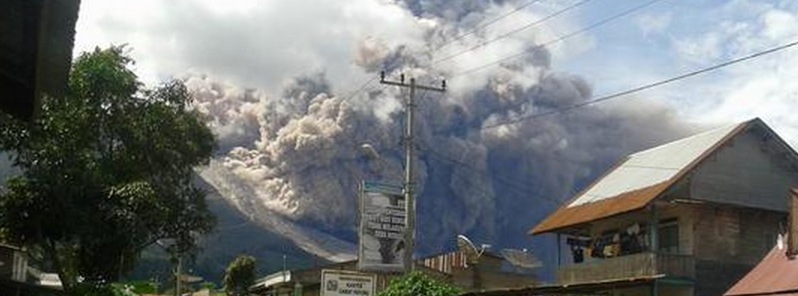Large pyroclastic flows at Mount Sinabung, Indonesia

A new set of moderate eruptions at Indonesia's Mount Sinabung volcano produced large pyroclastic flows on June 12 and 13, 2015, ten days after authorities raised the alert level to highest (4/4) and ordered evacuation of all people living within a 7-km radius. Media reports mention some people still ignore official warnings and refuse to leave.
By June 2, Sinabung's lava dome has grown in volume to more than 3 million cubic meters and continued at a rate of 100 000 cubic meters per day.
Small to moderate eruptions accompanied by pyroclastic flows reaching 1.3 km were observed during the past week until Friday, June 12 when a new moderately strong eruption triggered large pyroclastic flows and spewed volcanic ash that blanketed the surrounding areas.
Country's Volcanology and Geological Disaster Mitigation Center (PVMBG) reported that Friday's eruption took place at 10:42 local time (03:42 UTC) and lasted for 10 minutes.
#Sinabung #volcano today – the growing dome and small pyroclastic flow – Mbah Lewa https://t.co/v5HEDSTWsa pic.twitter.com/yRmys7mNbW
— Janine Krippner (@janinekrippner) June 12, 2015
PVMBG’s Wendy Cahya said pyroclastic flows on Friday reached as far as 3 kilometers (2 miles) south of the volcano while the volcanic ash reached up to 500 meters above the crater and drifted east.
Ash produced by this eruption hampered the activities of those living in areas that are located north of the volcano, particularly in the city of Berastagi, a popular tourist destination located 30 km from the crater. “Half of the city is covered today by drifting ash from the volcano,” Cahya told The Jakarta Post on Friday.
By Saturday evening local time, 11 avalanches of hot ash had been recorded, Cahya said.

In their volcanic ash advisory issued 14:08 UTC on Saturday, June 13, Darwin VAAC said low level volcanic ash is still present in the area. At 11:00 UTC on June 13, volcanic ash was reaching 4.2 km a.s.l. and was extending 3 km to the SE.
PVMBG advised explosive eruptions are possible at any time.
#Sinabung ERUPTION June 13 – 13:15 pm Taken from Payung Village by Nursheri Pandia @infobencana @chematierra pic.twitter.com/ajB2TQmT4w
— #Sinabung (@SinabungVolcan) June 13, 2015
#Sinabung by @BeidarSinabung ..she hits now.. #erupt [3] June 13 – 13:20pm view Rimo Kayu @infobencana @chematierra pic.twitter.com/07Ehtth2Ek
— Leopold Kennedy Adam (@LeopoldAdam) June 13, 2015
White plumes rose at most 1 km above the crater, and lava flows on the flanks were incandescent as far as 2 km S and SE from June 5 – 10, PVMBG said. Pyroclastic flows traveled 0.7 – 1.3 km daily down the S and SE flanks. Ash plumes from pyroclastic flows rose as high as 1 km during on June 5 – 6 and 10.
Geologic summary
Gunung Sinabung is a Pleistocene-to-Holocene stratovolcano with many lava flows on its flanks. The migration of summit vents along a N-S line gives the summit crater complex an elongated form. The youngest crater of this conical, 2460-m-high andesitic-to-dacitic volcano is at the southern end of the four overlapping summit craters.
An unconfirmed eruption was noted in 1881, and solfataric activity was seen at the summit and upper flanks in 1912.
No confirmed historical eruptions were recorded prior to explosive eruptions during August – September 2010 that produced ash plumes to 5 km above the summit. (GVP)
The following video was recorded on January 21, 2014 by Earth Uncut TV:


Featured image: Mount Sinabung eruption on June 13, 2015. Credit: Nursheri Pandia

Commenting rules and guidelines
We value the thoughts and opinions of our readers and welcome healthy discussions on our website. In order to maintain a respectful and positive community, we ask that all commenters follow these rules.